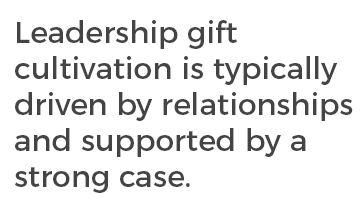

The state of the world has made us want to connect with more of you, more often. For the rest of 2020, the Campbell & Company Communications team is sharing a new article every week that explores a topic in case development and fundraising communications, drawn from our work.
Whether it’s thinking about how to approach fundraising communications against the backdrop of current events or tackling an evergreen challenge we see time and time again in nonprofits across the sector, these articles focus on practical tips to empower fundraising leaders in their day-to-day work. Subscribe to the series here.
When we do our Fundraising Communications webinars every year, one of the most common questions we receive in Q&A is “do I need different cases for different donor audiences (alumni, parents, corporations, foundations, etc.)?
The answer to that question is “ehhhhhh”—basically, don’t waste time worrying about that until you’ve done all the work to produce one really great, really versatile case for support that works for a variety of uses and audiences. But there is another sense in which, yes, you do need multiple cases in your campaign. Not across audience segments, but across time.
A fundraising campaign with a typical quiet/public phase structure needs three and a half distinct cases for support. Each comes at a distinct stage of the campaign, targets a different subset of your audience, has distinct functional objectives to support fundraising, and builds on the previous case in specific ways.
This isn’t a revolutionary insight or a novel prescription. In the natural lifecycle of campaigns, many organizations evolve through these different cases without quite recognizing them as such. But there’s a big difference between stumbling through them by trial-and-error and planning for them with intention.
Let’s look at what they are and how to approach them.
This is the preliminary trial-balloon case for support that you test—usually through a feasibility study with interviews, focus groups, and/or a survey—before launching a campaign. We call ours a “campaign preview”—formerly a “prospectus,” but we got over ourselves.
The audience for this case is often narrowly focused on the top prospective donors—though this is coming under question as people across the sector, us included, explore more community-centered and inclusive approaches to fundraising.
Its essential function is to give the reader enough of a picture of the campaign so that they can give you meaningful feedback. It’s also frequently your first real pass at getting the campaign vision out of your heads and onto paper, committing even provisionally to potential campaign projects/priorities, and beginning to build consensus with a group of leadership and volunteers.
Remember its purpose. This case has a mayfly’s life. All it really needs to do is generate feedback that gives you insight with which to write Case 2, your first full case. Try not to drive yourself bonkers overengineering it.
Keep it short. Every word you add decreases the likelihood that people will actually read it before you talk to them, so try to keep it under 1,200 words. It does not need to go into full detail on campaign projects.
Keep it simple. Although we have experimented with video and microsite versions for specific client situations, this should usually just be a short narrative document with minimal design. A two-page outline with the right content will totally work.
This is the first full case that you create at the outset of the campaign, and getting it ready for prime time is one of the first milestones on the way to beginning major gift cultivation.
While this case is intended to support leadership/major gift cultivation, its most critical audience is actually your leadership and campaign volunteers.

So while you of course want to use everything you learned in the feasibility study to hone your messaging for major prospects, what you most need is a case that gets your highest-level solicitors out the door talking to key prospects with passion and confidence.
Involve leadership in defining the case. This is their case to use, and they must be actively engaged in the case development process in order to take ownership of it. That sense of ownership is as important as the final product.
Focus on clear core messaging. Leaders and volunteers embrace their fundraising roles when they feel absolute clarity and confidence about what story they need to tell. That means building this case around powerful, simple messages that work in conversation.
Use the format that works best for your people. What kind of document is most useful to support them in a live conversation? It’s probably not a traditional lengthy narrative case statement. Think about an easily customizable presentation deck suitable for iPad or Zoom sharing, a printed flipbook that they can walk through in a conversation, and supporting talking points, FAQs, or a one-page cheat sheet.
Provide enough detail to build confidence. Unlike Case 1, Case 2 needs to describe your plans in reasonable depth. Not every donor needs it, but some do, and your volunteer solicitors in particular won’t make their calls if they’re worried about getting caught flat-footed with a question they can’t answer.
This one is not always necessary and can take many forms, but most campaigns benefit from some kind of mid-campaign case refresh while they’re still in the quiet phase—sharpening messaging and applying what you’ve learned in the first wave of cultivation.
Often this need arises when you finish soliciting most of your leadership gifts and need to gear up to cultivate the much broader middle of the gift table.
Step back and reflect. Ask everyone who’s been involved in leadership gift solicitation: What are we hearing consistently in our donor conversations that we should apply to the case? What messaging resonates, and what should be altered or de-emphasized? How are our case materials working for us, and how are we using them?
Update the materials you have. Case 2.5 often doesn’t require creating new case materials—just updating the ones you have, both for content and for usability.
Consider additional materials. That said, Case 2.5 is often where a leave-behind brochure becomes useful—you don’t need it for top prospects, but when you’re cultivating at broader scale, it can be very helpful to have something you can leave behind that continues the cultivation process for you between visits. Also, consider again whether your solicitors need additional support resources if you didn’t produce them already—talking points, FAQs, cheat sheets.
This is the case and messaging you use to support the public launch and communications strategy of your campaign.
The audience broadens dramatically here to include most or all of your organizational community, including a range of lower-level prospects, non-donors, and other community audiences.
You need to revisit your case not only to target different audiences, but to support different goals. This is the phase in which participation and acquisition become more important than bottom-line dollars, and the campaign becomes as much about communicating vision and strategic direction as raising money. You also begin communicating through mass communications channels that have broader reach but lower attention and engagement relative to a major donor conversation.
Simplify your message. The full length of your major donor case is likely too unwieldy for the channels that dominate in the public phase. Distill your case to a core set of simple messages that focus on the vision, the sense of moment and urgency, and a call to action that emphasizes participation, collective action, and membership in the organizational community.
Consider fresh creative concepts. While your campaign name and core messaging probably shouldn’t change, you may want to introduce fresh visual elements, language, storytelling approaches, and creative ways of bringing your case to life in public phase channels.
Mobilize your ambassadors. Think of your entire staff and volunteer corps as ambassadors for the campaign and equip them with simple resources (talking points, FAQs) and coaching/training to get them comfortable articulating the case for your campaign in their own words.
Your case is a living thing that can and should evolve throughout your campaign. At any given moment in your campaign, there are distinct things you need from it (and other things you don’t need to worry about). With this framework in mind, you can focus on what’s most important and take an intentional approach to updating your case to support you at every stage.